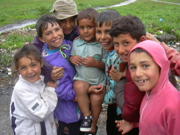HEALTH AND THE ROMA COMMUNITY, ANALYSIS OF THE SITUATION IN EUROPEEuropean Programmes - Health

Overview of the programme
- Priority Area: Health determinants
- Beneficiary Group: Roma population
- Period of the programme: 2007 - 2009
- Total Budget: 611.775 euros
Contact in Slovakia
HEALTH AND THE ROMA COMMUNITY, ANALYSIS OF THE SITUATION IN EUROPE
The Roma in Slovakia
In relation to the ethnic composition of its population, Slovak Republic is one of the most heterogeneous countries in Europe. This multiethnic character is evident in the fact that at least 20% of the population is non-Slovak. The Roma in Slovakia are the second largest minority in the country.
Very problematic is the ethnic identification and evaluation of members of the Roma community mainly on the basis of visible anthropological characteristics (which is an approach perceived negatively by Roma). Surviving racist prejudices among the majority population, which are applied without difference to all Roma and which are expressed in various forms of the so-called distance behavior, is borne by a part of the Roma community with greatest difficulties.
The censuses of 1991 as well as of 2001 confirmed that only about one third of the Roma in Slovakia officially declared their affiliation with the Roma minority (80,627 and 89,920 people according to the final results). Realistic estimates by the Slovak demographic experts say that there are about 350,000 - 370,000 Roma in Slovakia today. That represents about 8 % of the total Slovak population.
Reproduction patterns - Health - Life expectancy

Roma minority is characterized by different long-term reproduction patterns and permanent population growth, especially in the backward Roma settlement communities. In the long-term, its permanent growth in numbers will continue. At the same time, life expectancy is lower than that of the majority population and mortality higher among both children and adults. The Roma population has a different age structure and a higher share of children and youth than the majority population. One persistent negative phenomenon is the considerable number of women who give birth to their first child as young girls (in the 1990s, on average, more than 7,000 childbirths per year were registered in which the mother was under 18). Almost half of the Roma population in
Quotations from the article "The Roma in
Resource: Romano nevo l'il
Highlights
This programme arises from the project "Health and Roma Community, Analysis of the Situation in Europe" which has received funding from the European Union, in the framework of the Public Health Programme.
Coordinator: Fundación Secretariado Gitano.
C/Ahijones s/n . 28018 Madrid (Spain)
Telephone: +34 - 91 422 09 60 / Fax: +34 - 91 422 09 61
nuria.serrano@gitanos.org / elena.saura@gitanos.org







